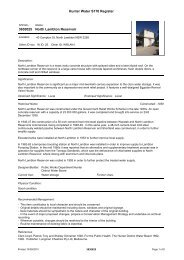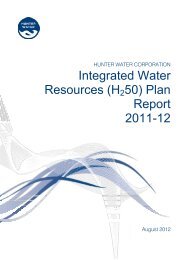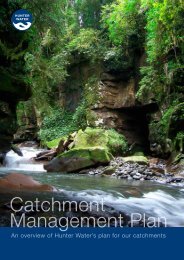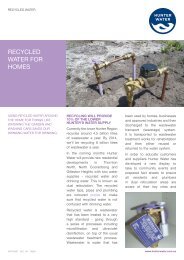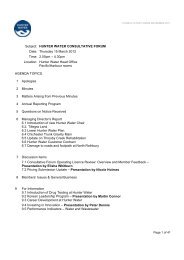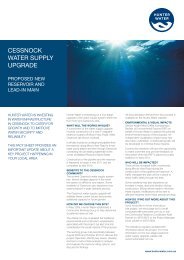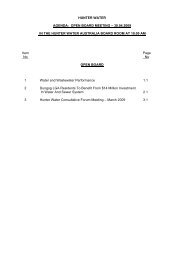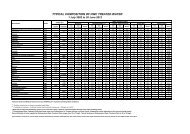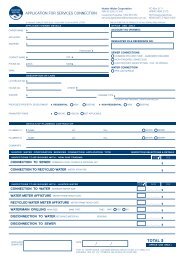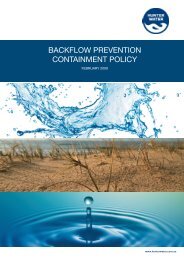Water Kit - Hunter Water
Water Kit - Hunter Water
Water Kit - Hunter Water
Create successful ePaper yourself
Turn your PDF publications into a flip-book with our unique Google optimized e-Paper software.
BEING WATERWISE AT SCHOOL<br />
actions<br />
1 <strong>Water</strong> meter readings<br />
Read the water meter every day for a month and record the results.<br />
This can be done at the beginning and end of each school day -<br />
which will help you to check for leaking pipes or taps (ie you will<br />
be able to detect water use overnight when no one is using taps,<br />
bubblers and toilets).<br />
2 Desktop review<br />
Collect information from as many bills as possible. <strong>Hunter</strong> <strong>Water</strong> bills<br />
are issued every four months. Tabulate the amount of water used,<br />
the number of billing days and the cost of the water. Ask the school<br />
administrator to keep future bills for your study.<br />
3 <strong>Water</strong> audit<br />
<strong>Water</strong> audits vary but usually include the following:<br />
• Conduct an inventory of every water fixture in the school (eg taps,<br />
toilets, bubblers, showers) and identify if any of these are leaking.<br />
• Measure the rate of water flow from school taps, you need to<br />
select at least one tap inside and one tap outside.<br />
• Measure the amount of water wasted by a dripping tap and<br />
calculate this over a year. This is best done by using a stopwatch<br />
and a measure to collect the water. Measuring the waste for a<br />
minute is a good point to start from.<br />
4 Stormwater, flooding and drainage<br />
Researching stormwater, flooding and drainage issues can also be a<br />
useful component of a water audit.<br />
5 <strong>Water</strong> saving strategies<br />
Discuss and develop strategies to conserve water across a variety of<br />
water uses in the school.<br />
6 <strong>Water</strong> saving action plan<br />
Develop an action plan that summarises the results of the desk top<br />
review and water audit, and the water saving strategies developed<br />
over the previous steps. The action plan can set targets for the<br />
school to become more water wise and makes recommendations on<br />
how to implement the water saving strategies.<br />
tips<br />
• This will highlight whether there are any leaks. Leaky pipes can<br />
waste 90 litres of water a day and a dripping tap can waste 45 litres<br />
a day.<br />
• The meter readings will also show daily patterns in water use. Large<br />
amounts of water use on weekends should be investigated.<br />
• If you have bills over several years compare water use over time.<br />
Take into account any changes in the number of students enrolled<br />
each year. The data can be used to calculate a figure for water<br />
usage expressed as kilolitres per student per day.<br />
• Results may show a trend but more importantly show how much<br />
money the school is spending on water. This will provide baseline<br />
data so savings can be calculated as waterwise activities begin.<br />
• Identifying the places where water is used will help you locate any<br />
problem areas.<br />
• Identifying leaking taps is critical in a water audit.<br />
• Measuring the amount of wasted water will show you the extent of<br />
the problem. Dripping taps waste more water than people realise.<br />
• Get a map of your school and outline key waterways, drainage lines,<br />
flood prone areas, then discuss how you could manage, reduce or<br />
improve things.<br />
• Students can develop their own strategies to save water including<br />
ideas for individual and group actions.<br />
• Some strategies might require the support or cooperation of other<br />
people eg plumbers. The P&C committee can be involved to help<br />
raise money for the purchase of water saving products eg rainwater<br />
tanks, water efficient showerheads.<br />
• Prioritise the strategies with regard to importance, time and<br />
money. This information feeds into the Action Plan and the School<br />
Environmental Management Plan.<br />
• Ideally involve the whole school community in the action plan.<br />
• Set realistic targets and recommendations.<br />
• Include an education and communication plan to help promote the<br />
plan and ways in which wasteful water habits can be changed.<br />
• Information developed through the action plan can then be included<br />
in the School Environmental Management Plan.<br />
7 Implementation and monitoring<br />
On implementing the action plan, set up procedures for monitoring<br />
and evaluating to see how effective the school has been in meeting<br />
the targets and recommendations set out in your action plan.<br />
• Contact other local schools to find out if they have undertaken<br />
a water audit and how they implemented their action plan. What<br />
difficulties did they face and how did they address these issues?<br />
• Identify areas where the community may be able to help. For<br />
instance, local businesses could be called upon to help the school<br />
purchase water saving products; service clubs could help provide<br />
labour for the installation of these in the school.<br />
• Promote and celebrate achievements.<br />
<strong>Water</strong> kit . ssS . 001 . april 2010<br />
9




